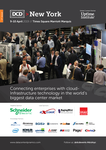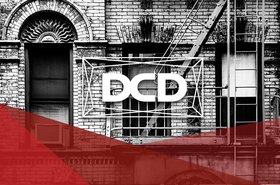Ahead of DCD>New York, Sagi Brody, CTO, Webair sat down for a Q&A with DCD's Kisandka Moses, who is producing this year's conference, to discuss the evolving demands of data center owners, the rise of the cloud and the shift to hybrid models in the age of data center diaspora.
Q:The data center ecosystem is shifting quickly and over 30 percent of DCD subscribers have identified hybrid cloud, cloud orchestration and managed services as a key challenge moving forward. Is there anything about the pace of cloud adoption that has surprised you at all?
A: I don't think it's necessarily surprising but it is fast moving and it's moving in the right direction. The industry's perception of the proper way to utilize different platforms including cloud is changing and moving quickly from public cloud to a hybrid edge world.
Enterprise users are saying to the hyperscale, "we like what you're doing in the public cloud but what are we supposed to do with the other 30 or 40 percent of our workloads that we've learned are just not a good fit?". Hyperscalers are acknowledging that it is going to be a hybrid world and a multi-cloud world.
When we talk to enterprises about cloud migration, we do not touch on what cloud is better but rather what the workload is and the unique requirements for security, latency and complexity. We are seeing many enterprises enter into an a-ha moment where they realize that their future infrastructure is a reference architecture that promotes flexibility and maintains security and performance above all else; this is the sort of the goal that they should be looking towards.
More on DCD>New York
-

DCD>New York 2019 Delegate Brochure
See what's new for 2019 at the world's largest enterprise data center show, bringing together over 1,500 data center experts from across the US.
-

Event News Spotlight on Data Center Modernization at NYC Conference
DCD>New York agenda to explore extent of “hidden data center sector” for upgrades and retrofits
-

DCD>New York 2019 Industry Interviews
Experts weigh in ahead of DCD>New York
Q: What do you see as the future for the enterprise data center? With the migration we are seeing to cloud coupled with greater demands for latency, is the future at the edge?
A: At Webair, we paint this beautiful vision of a hybrid or edge for the enterprise but this is distinct from the conversation about edge compute. Let's walk through an example:
An enterprise goes to the hyperscale who is hosting 30 percent of their workloads. They have installed Azure in their office and for some customers when it's all working properly it'll be fine.
For other customers however, particularly the mid-market enterprise, they are now shifting their operational mentality to this service consumption OpEx type of model. They might push back on Azure and say "it's really put your cloud in a box" when they did not want to be accountable to manage, monitor or buy hardware. For those that are working on a service consumption model, they will want the Azure stack delivered with a SaaS model.
There is longevity for regional edge providers playing a part in the hybrid IT world. They are the delivery vehicle for the edge variants of the public cloud. For the enterprises who are comfortable bringing the platform in-house and wanting to run the Azure Stack or AWS Outpust, there is life for data centers but maybe not as big anymore.
We often talk about running physical connectivity to our customers, connecting it back to our private clouds and airgapping it from the public internet which provides them with cloud that looks, feels and acts like it's part of their firm. Once they're connected to us, we can still provide the onramp to public cloud. It is important for us to be the entity with the workload's best interests.
In the future, one party will need to be the hybrid orchestrator. They will need to own the hybrid IT between all these platforms as it gets more complex. Who has the appetite to own it?
Q: There is one panel in particular we will host at DCD>New York in April with a focus on the shifting capacity from New York to Virginia. Do you see there being enough activity and demand from Wall Street to justify any new builds in New York or is all new capacity going to eventually end up in Virginia?
A: I believe the New York market was overbuilt. Hyperscalers are not going to take multi-megawatt sites in the New York metro. Ashburn is going to provide more attractive pricing and scale and there's a general consensus that it'll do a good job of servicing the New York market for general purpose.
Edge is a completely different story. So will there need to be edge deployments in New York? Yes, that's probably where you'll see the growth. There will be a larger number of smaller deployments for the purposes of the edge metro interconnection, with Ashburn [becoming a hub for] a smaller number of larger individual deployments.
Q: Our closing keynote panel at DCD>New York will bring together thought-leaders from the world of colocation, cloud, semiconductors and beyond to list predictions for everything from evolving site selection shortlists to average density per rack and colocation thresholds for capacity. Would you like to make a prediction on an area of interest, perhaps how you see hybrid market or cloud market evolving?
A: I think we're going to see a lot of talk about computing capability at the edge - serverless compute at the edge which will come from many directions. The content delivery networks will drive demand for more compute capability at the edge; as will the hyperscalers. The key to the trend taking off, will be a prolific standardized platform-as-a-service. We will see a platform emerge which is deployable inside a data center in the public cloud, that can be consumed wherever users are located.
Q: It would be interesting to get your thoughts on some of the new technologies being much discussed in our industry at present. Let's start with liquid cooling - there is still a lot of debate on whether liquid cooling will become mainstream. Can it make its way into the enterprise data center or a colocation facility?
A: If you're a colocation provider, you have you no say on what equipment your customers are bringing in and liquid cooling would likely require hardware modification and special disks. It is an extremely niche type of technology, requiring a high level of cooperation from the equipment that's in the rack. If a colo customer has a need for HPC for example, and a traditional type of environment is not going to provide enough cooling, I think the colocation provider could make some changes and adapt to find the solution. If it's more of a general purpose application however, for example a retail colocation facility offering 0 to 20 kW racks, I don't think it makes sense.
It is certainly more appropriate for a hyperscaler who owns the decisions on the hardware and on the datacenter infrastructure.
Q: We're seeing a lot of talk about software-defined technologies in the data center universe. There are multiple use-cases in which software-defined networking has been shown to offer considerable efficiencies. Do you think SDX will take-off as a technology?
A: Yes, absolutely. I'm very interested and very involved in software-defined networking.
The companies that are making big strides in SDN are PacketFabric, Megaport, Equnix and Epsilon. the software-defined interconnection companies are going to virtualize the public transport network and this will be transformative in many ways. We are using those platforms to compete against our competitors and provide a better service.
This is going to be a big year for SDN providers and software defined security will also be a big theme this year. With Cyxtera, you have a colocation facility with 52 data centers who are buying security tools. They are trying to build the software-defined security perimeter around a physical datacenter and to my knowledge, no-one else is looking at it from that perspective.
Q: I want to probe you on the edge phenomenon. Do you think we'll see any progression on the use of networking edge in the data center this year?
A: With edge, it is almost becoming a perfect storm with the uptake of software-defined network fabrics. If you are a edge compute manufacturer or operator, the network fabrics will deploy everywhere and take the networking problem away. Then you have 5G driving a need for the edge. The only missing piece is connecting the cellular network to the edge data centers. That will need to happen next, but you have a lot of startups working on physical containers which will be deployed everywhere and they are also
talking to the network fabric companies and getting them in all of their sites.
It will be tricky to get the traffic from the cellular network to the closest edge facility. This will require the cooperation of the carriers. This might not happen until the carriers start to feel the pain of the capacity constraints once 5G takes shape.
Q: What is your take on green and sustainable initiatives within small-medium sized urban data centers; will PPAs and renewables for example be on the priority list to investigate?
A: I think microgrids and renewables are always interesting if it can save you money. Being energy efficient is always something that owner-operators should be assessing and every operator wants to reduce operational costs.
It is true, however, that the regional data center operators might not have as much of a long term plan as some of the bigger operators who are owning the real estate and as such, have a 20 year plan.
Sagi will join us at DCD>New York on April 9-10, to share his insights into "What is the right level of hybridization for your IT infrastructure.

